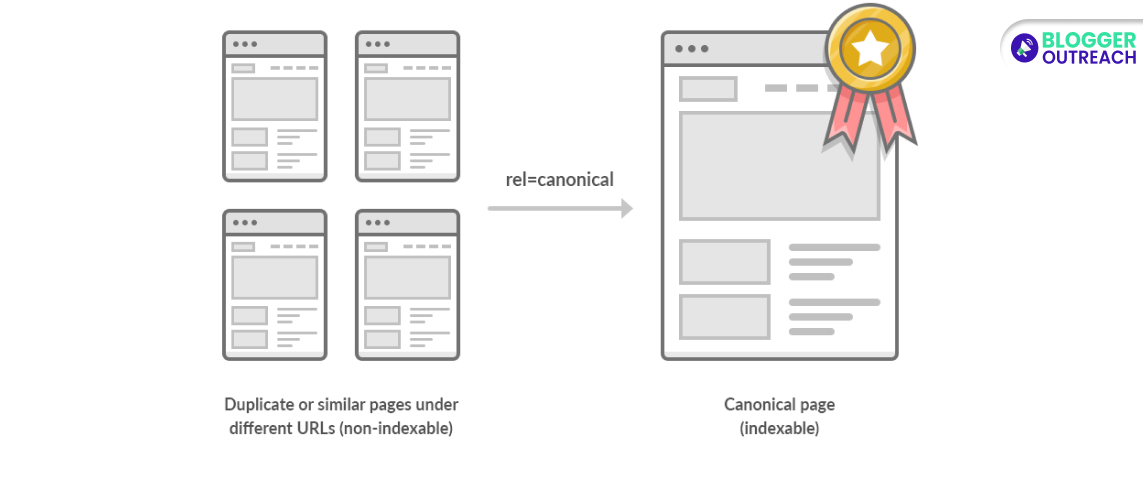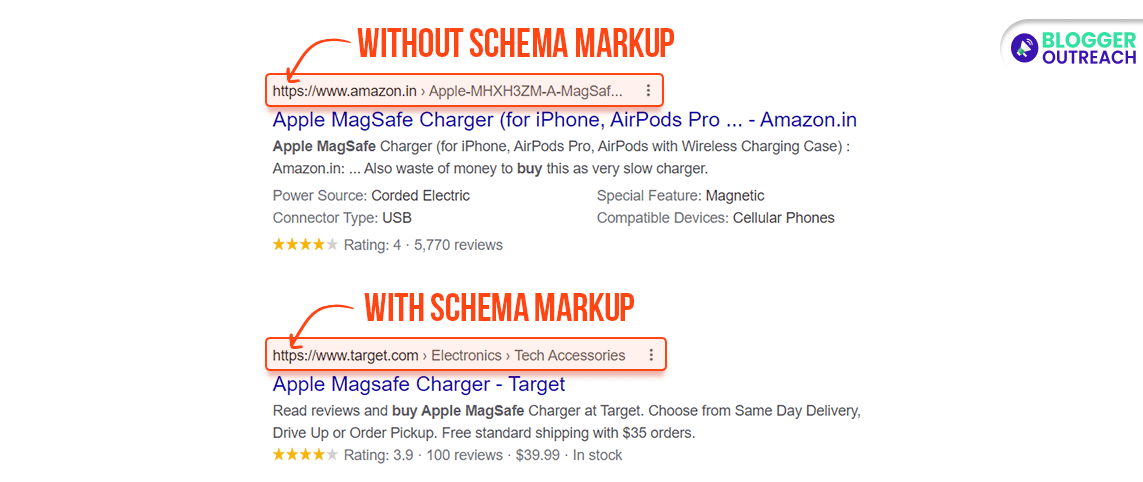Table Of Content
- 1 Optimize Your Ecommerce SEO
- 2 Ecommerce SEO Strategies
- 3 Top 5 Ecommerce SEO Strategies By BloggerOutreach
- 3.1 1. Harness The Power Of Canonical Tags For Paginated Pages
- 3.2 2. Elevate Search Results With Schema Markup
- 3.3 3. Optimize Site Structure And Navigation For Intuitive User Experience
- 3.4 4. Craft Compelling Product Descriptions And Titles With A Formula
- 3.5 5. Uncover Long-Tail Keywords With Google Trends
- 4 Conclusion
Online enterprises should understand e-commerce SEO strategies to compete favourably in the modern digital landscape. Consumers are more mobile-savvy than before and hence your eCommerce SEO strategies should be mobile-responsive.
It is not hard for e-store owners to engage smartphone users. This strategy will help you to get to the top of the search engine results in the long run. Nonetheless, most online stores fail when it comes to e-commerce SEO.
These businesses fail to make maximum use of organic ranking. This article puts forward some of the best e-commerce SEO strategies that will help you scale up your online store and increase profitability.
Optimize Your Ecommerce SEO

You can lose a lot of revenue if you don’t act in a timely manner. You should put in place an effective SEO strategy that will help you to accomplish your business goals. The best SEO optimization strategy will get you to the first pages of the SERPs.
Be ready for the various shopping seasons such as New Year, Christmas, Halloween, Cyber Monday, and Black Friday. Do not allow any of these opportunities to pass you by. Optimizing your online store will help you get more clients.
In the absence of proper planning and the right strategy, you won’t be able to engage with your audience and this can make you lose a high volume of sales. You can make use of several e-commerce SEO tactics.
Ecommerce SEO Strategies
It is crucial to optimize e-commerce for SEO but this is not rocket science. So many tutorials are available online but you can also outsource a professional. These professionals will help you with e-commerce SEO optimization.
1. Website Architecture

Website architecture matters a lot irrespective of the size of your e-commerce store. If your site is built on CMS, you will rely on the pre-provided architecture.
Some of the leading e-commerce platforms include Magento, Shopify, and WooCommerce. Most of them utilize stacks that enhance the performance of the website.
Website architecture refers to the structure of the whole website. It comprises web hosting for e-commerce, installed applications on the server, additional add-ons and plugins that will keep your site up and running.
There is a direct relationship between the architecture of your website and its performance. It is one of the best ways to improve the ranking of your website in the search engine. You need to;
- Use a Free SSL certificate to secure your site.
- Optimize your site to make it mobile-responsive.
- Install server caches such as Full Page, Redis, Nginx, and Varnish caches if you are using Magento.
- Install AMP pages.
- Install the image optimization plugins on the e-commerce platform.
(i) Site Structure
You need a simple structure for your e-commerce website to allow the flow of link juice from the top to the bottom. You can make every product page to be only three clicks from the homepage. Remove all pages that take more than three clicks from your homepage as it complicates the user’s journey.
(ii) Add Breadcrumbs
Adding breadcrumbs will also assist you to optimize your website. Currently, Google displays breadcrumbs in the search index. According to SEO professionals, it provides more importance and a higher possibility. However, there isn’t an official announcement with regard to this element.
When you include breadcrumbs on your site, it will help your users to track their journey easily. Clear web navigation will help visitors to access your web content with a lot of ease.
(iii) Optimize Your Site Links
Google adds web links to all websites in organic searches. You cannot tell Google about the pages as part of the website links in the search bar because this process is automated fully. The only thing you can do to optimize is place the links in the pages that are most visited or the pages you would like individuals to visit at the prominent places on the website.
(iv) Maintain the Right Internal Linking Structure
The next thing you need to do is add internal links on every page you would like to enhance value from the other pages to evenly spread the link juice. Apart from helping users to get your products online, it also enhances your ecommerce SEO efforts.
Deep links help both in deep link discovery and are relevant for search engine optimization. It is applicable to mobile apps as well as websites.
2. On-Page Ecommerce SEO For Your Store

After optimizing the structure of your website, you should move to the on-page elements of your online store. It implies optimizing code and content on every page to enhance the search ranking so that it is readily discoverable in the SERPs.
(i) Prepare A List Of Keywords
The first thing is to prepare a list of the keywords you would like to rank on the e-commerce store. Make sure that the keywords you are using are relevant to your products and services. Use paid tools like kwfinder, Moz, and Ahrefs to search for these keywords.
Keep on searching for variations until you get the ones that are ranking highly. The most important thing is to search for keywords that suit your needs.
(ii) Optimize Your Ecommerce SEO For Voice
The next thing you need to do is optimise your e-commerce pages for voice. Make sure you take a conversational approach when doing this. The voice bots of Google pick content from FAQs and hence you should include this page on your website.
Content that is on your FAQ page receives higher importance, especially when dealing with the 9th-grade level of reading. This content should drive conversations at a level of reading that is easy. The readability analyzer allows you to check the level of reading for your content.
(iii) Improve The Speed Of Your pages
Google uses the speed of your website to rank your pages. Therefore, it is an important aspect of e-commerce SEO. Google’s algorithm uses page speed as one of the signals for website ranking. According to research, Google could be using the time to the first byte when looking at the speed of your website.
Therefore, web speed plays a critical role in increasing the ranking of e-commerce sites. You can improve the ranking of your eCommerce store by using a tool like Google page speed.
(iv) Create Holiday Landing Pages
Most eCommerce stores create unique landing pages for various promotions. You will find them optimizing the pages to help them get high rankings in the search engine. The pages will remain online during the promotion and even after that.
Once they become authoritative and old, it helps them get critical link juice. We refer to this as Page Authority (PA) or Trust Flow (TF) in SEO terminologies.
You can also develop landing pages that are relevant to your promotions. The ranking of these pages will increase every year through paid and organic marketing strategies.
(v) Product Page Description
There aren’t some set of rules for writing product descriptions for the search engine. However, you should remember a few points for effective eCommerce SEO while working on product descriptions.
The length of the description should range between 300 to 800 words for any regular product and over 1000 words for the high-selling products. Use a separate column to add the important features and place it strategically on the product page.
The other thing you need to do is create internal links between category and product pages. A product description that has over 1000 products should have 3 to 5 links.
It is good for your product pages to have a review section. Motivate the buyers to interact with your ecommerce store and provide a review of their experience. Your blog will even rank for the “Review” website and bring in more traffic.
Also, add a tabular structure for the product specifications as it will enable the search engines to pick up snippets from your web pages for zero rankings. It is good to learn how to build a web page that will convert into e-commerce SEO.
If possible, display your discounted prices in snippets. Google users who are searching for the best discount deals will land on your site once they click on such offers.
(vi) Create Guides For Your Clients
The last thing you need to do is create guides for your online shoppers. You can make them in the form of a video or an e-book so that they can learn to use your product. The other thing you can do is ask them to subscribe to your email newsletter because it is an effective e-commerce SEO for marketing content.
You can also create them in the form of landing pages to allow your users to learn about everything on the page. It is one of the best e-commerce SEO strategies that you need to implement.
3. Off-Page Ecommerce SEO

After on-page e-commerce SEO, the other thing you need to look at is the off-page SEO. It comprises affiliate programs, sponsorship, or partnerships. Here are some of the things you need to implement to implement to make your off-page strategies succeed.
(i) Announcements And Link Building
Begin by building basic links for the initial promotion of your products. The best starting point can be blog comments, citations, Q&A sites, web 2.0 links, and social bookmarking websites in promoting your offers.
These submissions may fail to deliver the desired link juice that your site requires to rank highly. However, it will help you to create a significant impact on your search rankings. You will see several fluctuations as the algorithm continues to analyze the algorithm of your site.
To sustain a high ranking, it is good to link from third-party sites to the main landing page. Use tools such as ‘Getty Images Embed’ so that other users can link to your products whenever they add code to their blogs.
Create a different blog that reviews the products of your website. It will create some kind of PBN (Private Blog Network). Google does not like PBN if its primary intention is to create links. Therefore, you need to develop unique guides that you can use to promote your offers.
(ii) Stripe Partnerships
You may decide to strike partnerships with affiliate sites that work within your industry. You will pay a small proportionate commission to the affiliate sites as they continue selling your products. It is good to enter into partnerships during the shopping season because you will not worry about getting sales.
Therefore, you need to strive to find an excellent affiliate site. Searching for “Buyers Guide” or “Reviews” will help you get several affiliate websites. Check websites that are ranking for the above keywords and contact their admins for partnerships.
(iii) Sponsorships
Sponsoring products on several blogs will also help you promote your offers during shopping. Several high-paying blogs do accept sponsored content and you can get to them to sponsor your products. In case you have multiple offers, you can directly contact their publishing network. These services can give you custom offers for promoting your blog.
(iv) Blogger Outreach
You can also use blogger outreach to promote your eCommerce store. In this eCommerce SEO, you will be reaching out to bloggers who your competitors are already using to link to their stores. Request them to put your promotions as part of their blogs.
Most of them will do it for free while others will ask for payment. You can choose what you feel depending on your unique needs.
It is also good to request backlinks from anyone who mentions your brand but have not linked to your website. You will get a positive vibe once they go the extra mile of linking to your website in their mentioning.
The last thing that you can do is ask for guest blogs. You can give them a few controversial ideas like ‘what is good for introverts between Samsung and iPhone.’ Think of similar blog topics and use the internet to reach out to many people.
(v) Pick The Right Promotion Influencers
Connecting with the right influencers will also bring eyeballs to your e-commerce store. Each influencer that you target should have his or her own website. It will help you to enhance your e-commerce SEO for better results.
Top 5 Ecommerce SEO Strategies By BloggerOutreach
By now you got an idea about the foundational ecommerce SEO strategies. It’s time to get deeper into it. We as an SEO expert’s team, have tried several strategies. Guest posting works wonders (if done right) for ecommerce SEO.
And…and…and…There are 5 tailored strategies that bring massive results:
1. Harness The Power Of Canonical Tags For Paginated Pages

If your ecommerce site has multiple pages with similar content, like page 1 and page 2, it’s important to use canonical tags.
These tags are like signposts for search engines. The engines understand the connection between pages.
Here, canonical tags play an important role. They actually combine the indexing properties of many pages into one representative page.
Moreover, you can prevent search engines from seeing each page as separate by using canonical tags. This can help you avoid duplicate content problems. Instead, you guide them to focus on the designated canonical page. Hence, you ensure a more cohesive and streamlined indexing process.
Because this not only enhances your site’s SEO but also provides a better user experience. Because you are actually presenting the most relevant content to potential customers.
2. Elevate Search Results With Schema Markup

To give your ecommerce site an SEO edge and enhance search result visibility, implement schema markup. Google’s structured data tools are instrumental in validating your markup efforts. Here are some key schema types to focus on:
- Product: Clearly define your products with structured data, providing detailed information that search engines can easily comprehend.
- Breadcrumb List: Implement breadcrumb navigation, offering users a clear path to navigate your site effortlessly.
- Website: Ensure your overall website structure is well-defined. So, it should allow search engines to understand the hierarchy and relationships between different sections.
- Organization: Clearly specify the organizational details of your ecommerce venture to establish trust and authority.
- Offer: Use structured data to showcase special offers or promotions, attracting potential customers with enticing deals.
- Aggregate Rating and Review: Displaying customer ratings and reviews through schema markup can significantly influence click-through rates and build trust.
- Image and Video Objects: Enhance the visual appeal of your product listings by incorporating schema markup for images and videos.

A user-friendly and intuitive site structure is a cornerstone of effective ecommerce SEO. Group your online store into categories that make sense to your target audience. Implementing breadcrumb navigation further enhances user experience by offering clear paths for exploration.
you need to help visitors find what they want. So, make sure your product categories and subcategories are clear. When you create an easy-to-use website, it makes users happy and improves your rankings.
Search engines like websites that rank user experience. Having an easy-to-use structure with breadcrumb navigation is a good start.
4. Craft Compelling Product Descriptions And Titles With A Formula

Creating unique and compelling product descriptions is a vital aspect of e-commerce SEO. Develop a formula for crafting product titles that capture the essence of each item. Here’s a simple yet effective formula:
Product Title Brand/Model + Style/Unique Feature + SKU(if any) + Color, Material, Elements + Further Details: size, weight, capacity, etc.
This formula ensures that each product title is informative, engaging, and optimized for relevant keywords. When you include important information like brand, style, and special features, it helps search engines as well as customers a complete view of the product.
Striking the right balance between creativity and informativeness in your product descriptions is pivotal. Furthermore, avoid duplicate content and prioritize originality to stand out in search engine results.
5. Uncover Long-Tail Keywords With Google Trends

To outrank the competition, it’s crucial to stay informed about search trends. Here, Google Trends comes into the picture. Basically, it is a powerful tool that allows you to compare search trends for different product types within a category.
When you analyze these trends, you can uncover valuable insights into the infusion of long-tail keywords.
Consider comparing a few types of products within your ecommerce category to identify emerging trends and user preferences.
This helps with keyword optimization and guides your content strategy to match market demands.
Conclusion
These e-commerce SEO strategies will help your store to rank higher in the search engines. It is the best way to get an organic ranking and a higher position in the SERPs. This practice needs effort and time especially if you are dealing with new products. Therefore, follow the aforementioned tactics to promote your eCommerce website.
If you need more explanation or don’t understand a specific tactic, feel free to contact us for the best advice.
Read Also:








